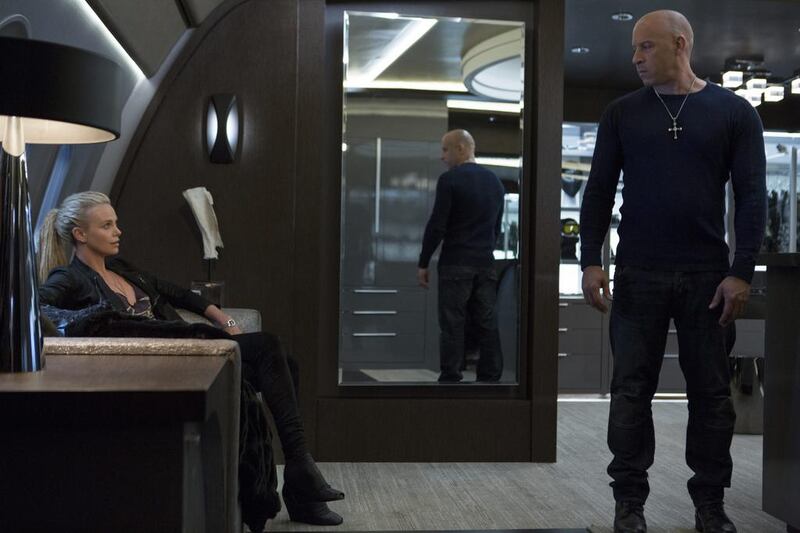There cannot be many – if any – movie franchises that make it to an eighth instalment with expectations still sky-high and Oscar-winning actors clamouring to join the party.
But then The Fast and The Furious is unlike any other film series. If sequels commonly obey the law of diminishing returns – creatively as the ideas dry up, and financially as audiences dwindle – F&F has radically bucked that trend, watching its fan base grow as its mythology flourishes.
When the eighth film, The Fate of the Furious, roars into cinemas tomorrow, who would bet against it eclipsing the monster US$1.5 billion (Dh5.5b) box-office haul of its predecessor, Furious 7, which was partly filmed in Abu Dhabi? All but one of the films in the franchise have outgrossed the previous instalments, after all.
What began in 2001 as a movie about illegal street racers in Los Angeles, made on a relatively modest budget of $38 million, has grown into a sprawling global crime saga starring some of the most powerful players in Hollywood.
It even survived the loss of actor Paul Walker who, with Vin Diesel, was part of the core partnership at the heart of the series. He died in 2013 in an off-set car crash during the making of Furious 7.
The franchise reinforces an old Hollywood maxim: when it comes to sequels, bigger is better. About 300 cars were built from scratch for the new film. There are also tanks, submarines and a giant wrecking ball – which might be a metaphor for the franchise and the way it smashes through any obstacle.
Yet this ludicrous excess has caught on with the acting community. Diesel takes centre stage as gang leader Dominic Toretto, and through the years, the supporting cast has grown to include Dwayne “The Rock” Johnson (Hollywood’s highest-paid star), Kurt Russell and Jason Statham.
The Fate of the Furious has pulled off an even bigger acting coup, recruiting two Academy Award-winners: Charlize Theron and Helen Mirren. Yes, the Queen herself is on board.
The roots of the franchise's success were obvious from the start, when the popularity of that first film, inspired by an article in Vibe magazine about New York street racers, caught studio Universal by surprise. After off-the-charts test scores, executives shifted it to a lucrative summer release – and reaped the rewards when it grossed $204 million worldwide.
“I never expected it to be a blockbuster,” said Rob Cohen, director of the first film. “I didn’t make it to be a blockbuster.”
Long before diversity became a high-profile Hollywood hot topic, Diesel and fellow stars Michelle Rodriguez and Jordana Brewster, among others, reflected the ethnic diversity on the streets in a way Hollywood had rarely managed – and still struggles with.
Still, few in 2001 would have predicted the movie had enough fuel to go the distance.
The sequel, 2003's 2 Fast 2 Furious, was directed by John Singleton and introduced recurring characters Roman (Tyrese Gibson) and Tej (Chris "Ludacris" Bridges). However, there was one glaring absence – Diesel declined to return. Despite this, it made enough money – $236 million – to convince the studio stick with it.
On the surface, the third outing – The Fast and the Furious: Tokyo Drift – seemed to signal the end of the road. A spin-off set in Japan, without Walker, it is the only film in the series to under-perform (making only $158 million) – despite a much-heralded (and rather cynical) cameo from Diesel.
Yet this cameo was a “pivotal moment”, the actor says, because “it allowed the studio to start from scratch”.
Diesel returned as a producer and figurehead, and with Tokyo Drift’s director Justin Lin mapped out episodes four, five and six, rewinding the clock so that they were set before the events of the third film.
Walker also returned, and the films mined themes of family and loyalty. It was like the world's most expensive soap opera, with an ever-growing fan base. As the franchise grew, so did its ambition. Fast Five went to Brazil. Fast & Furious 6 raced through London. By the time it came to Abu Dhabi, the franchise was established as truly global.
Where next? As one commentator noted after Furious 7, the only new place left to send the gang is outer space. The Fate of the Furious does not go that far, but does make pit stops in Cuba and Iceland.
Two more instalments are planned, with the second due in 2021 – the 20th anniversary of the first movie, marking the end of what has been an epic race.
• The Fate of the Furious is in cinemas from Thursday (April 13)
artslife@thenational.ae





